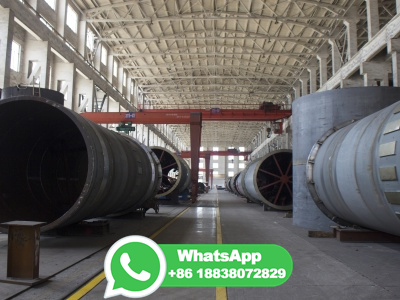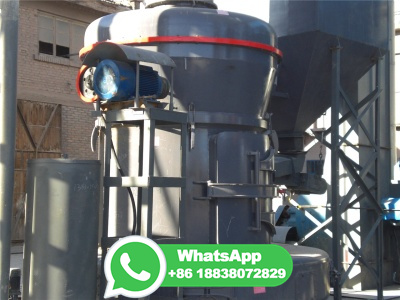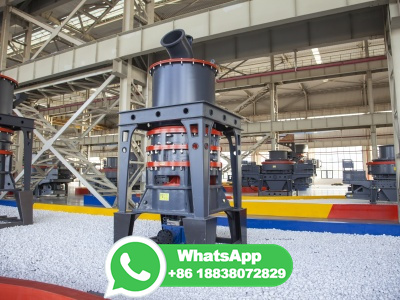
It is obviously seen that the stages of coal mining, cokemaking process and COG purification process contribute relatively higher impacts than other stages in every. Allocation procedures. The selection of allocation method has been one of the most debated issues in LCA methodology. In the above section, different allocation procedures were ...
WhatsApp: +86 18838072829
Coal is a mineral consisting mainly of sedimentary fossilized carbon with smaller amounts of other elements, such as sulfur, hydrogen, oxygen, nitrogen and m...
WhatsApp: +86 18838072829
However, other types of biochars need to be examined for fixed carbon content (>80 %) and calorific value (>27 MJ/kg) whether they want to be used instead of coke. In cokemaking process, it is possible to blend biochar with coal to make biocoke but it is necessary to keep biochar addition in the range of 210 % to hinder its unfavorable ...
WhatsApp: +86 18838072829
How a Coke Plant Works. Coal is the main ingredient used to make coke. Iron is produced by inputting coal into a blast furnace. However, coal cannot be put directly into a blast furnace because of all the harmful byproducts that come from that. So, there is an intermediate process that occurs. Coal is converted into coke first.
WhatsApp: +86 18838072829
Coal to Make Coke and Steel. Metallurgical coal (also called "met" coal) is an important raw material used in the steelmaking process, although very small amounts of coal (relative to the amount used for electricity) are needed. The coal used to make steel is heated without air in an oven at temperatures of as much as 2,060°F (1,125°F ...
WhatsApp: +86 18838072829
The coal blend quality and process control of coke making technologies is an important lever to produce quality coke with optimal cost. Apart from impacting cost, this improves the CO2 footprint.
WhatsApp: +86 18838072829
At first Bituminous coal is crushed and screened to a certain size. Preheating of coal (at 150250˚C) is done to reduce coking time without loss of coal quality. Briquetting increases strength of coke produced and to make non coking or poorly coking coals to be used as metallurgical coke.
WhatsApp: +86 18838072829
In coke making process, material in coal/coke bl end changes with the increase of temperature, and physical parameters ρ c, c c and λ c, presented in (1), vary as well. Then we suppose that ...
WhatsApp: +86 18838072829
Coal carbonization is the process by which coal is heated and volatile products (liquid and gaseous) are driven off, leaving a solid residue called coke. Carbonization of coal involves heating coal to high temperatures either in the absence of oxygen (O2) or in control quantity of O2. A gaseous byproduct referred to as coke oven gas (COG ...
WhatsApp: +86 18838072829
In essence, coke is kind of a purified coal. It's made by baking your basic bituminous coal in an airless furnace or oven at temperatures as high as 3,600 degrees but usually about 2,000 degrees ...
WhatsApp: +86 18838072829
lowering of the coke:iron ratio used in the blast furnace (e. g., increased use of pulverized coal injection). There were 18 coke plants operating in the U. S. in 2007. Process Description19, 16, 194 Most coke is produced in the U. S. using the "byproduct" process, and three plants used a "nonrecovery" process in 2007. The ...
WhatsApp: +86 18838072829
The coal blend quality and process control of coke making technologies is an important lever to produce quality coke with optimal cost. Apart from impacting cost, this improves the CO2 footprint.
WhatsApp: +86 18838072829
The coal blend quality and process control of coke making technologies are an important lever to produce quality coke with optimal cost. Apart from impacting cost, this improves the CO 2 footprint. Heat recovery stampcharged coke making technology was introduced in Tata Steel in 2008.
WhatsApp: +86 18838072829
Metallurgical coke is produced from lowash, lowsulfur coking coals in the coking process involving devolatilization and carbonization at ~ °C in airless ovens over 1820 h. Volatile hydrocarbon byproducts are later used to generate energy in separate combustion processes. Due to the limited supply and high costs of highgrade ...
WhatsApp: +86 18838072829
The blended coal mass is heated for 12 to 20 hours for metallurgical coke. Thermal energy from the walls of the coke chamber heats the coal mass by conduction from the sides to the middle of the coke chamber. During the coking process, the charge is in direct contact with the heated wall surfaces and develops into an aggregate "plastic zone".
WhatsApp: +86 18838072829
The fundamental aspect of the coal blending theory of low value coals to produce good quality of metallurgical coke in nonrecovery coke making process was investigated in this study by using the composite coking potential technique. The implementation of the technique has yielded use of up to 25% pulverized coal injection, 20% raw petroleum ...
WhatsApp: +86 18838072829
The "hearth" process of cokemaking, using lump coal, was akin to that of charcoalburning; instead of a heap of prepared wood, covered with twigs, leaves and earth, there was a heap of coals, covered with coke dust. The hearth process continued to be used in many areas during the first half of the 19th century, but two events greatly lessened ...
WhatsApp: +86 18838072829
lowering of the coke:iron ratio used in the blast furnace (e. g., increased use of pulverized coal injection). There were 18 coke plants operating in the U. S. in 2007. Process Description19, 16, 194 Most coke is produced in the U. S. using the "byproduct" process, and three plants used a "nonrecovery" process in 2007. The ...
WhatsApp: +86 18838072829
Metallurgical coal, also known as coking coal, is used to produce coke, the primary source of carbon used in steelmaking. Coal is a naturally occurring sedimentary rock formed over millions of years as plants and other organic materials are buried and subjected to geological forces. Heat and pressure cause physical and chemical changes that ...
WhatsApp: +86 18838072829
Metallurgical coke sounds like a soda beverage, but it's not. It is a refined carbon product made from a special kind of coal. Using extremely high temperatures, coal can purified into coke which is then used in the iron and steel making processes. One of the most important steps in the cokemaking process is choosing the right coal to use ...
WhatsApp: +86 18838072829
Coke is an important raw material in the steel industry, and its quality directly influences the smelting of iron and steel. To improve coal quality and reduce coal blending costs, we need to predict the coke quality and optimize the coal blending scheme. In this paper, we propose a modeling and optimization method based on the characteristics of the coal blending and coking process.
WhatsApp: +86 18838072829
The second step in coke production is to process the raw material, coal, into a consistency appropriate for coke oven achieve this consistency, coal is pulverized in a crusher and, if necessary, mixed with water and oil to control the density of the pulverized coal mixture. A basic diagram of the most common coke making process ...
WhatsApp: +86 18838072829
COAL BLENDS FOR COKE MAKING AND BLAST FURNACE COKE PROPERTIES Coal blend The coal selected to make coke is obviously the most important variable that controls coke properties. The rank and type of coals selected impact on coke strength. ... The FMC coke process was developed by FMC and Steel Corp. This process is probably the most ...
WhatsApp: +86 18838072829
Introduction to Coke making process. Coke making process involves carbonization of coal to high temperatures in an oxygen deficient atmosphere to concentrate the carbon. The volatile constituents of the coal, including water, coalgas and coaltar, are driven off by baking in an airless oven at temperatures as high as 1000 °C, so that the fixed carbon and residual ash are fused together.
WhatsApp: +86 18838072829
Coke is an integral component of the blast furnace charge; therefore, it plays an important role in the integrated steelmaking process. Achieving the required coke quality parameters by producers requires the use of a high proportion of the highest quality coking coals (hard coking coals) in the coking blends, which significantly increases the unit production costs. Approximately 75% of these ...
WhatsApp: +86 18838072829
Metallurgical coke is an important raw material for pig iron production in the blast furnace. During this process the coke undergoes severe mechanical, thermal and chemical stresses. One of these is the CO2 gasification which may lead to a decisive mechanical weakening of the lump coke by increased carbon burnoff.
WhatsApp: +86 18838072829
SunCoke Energy's heatrecovery cokemaking process converts waste heat into steam and electricity, which we can sell to our customers. A typical heatrecovery facility that we design and operate to produce million tons of coke per year can generate more than 90 megawatts of electric power per hour. With the average household using 11 ...
WhatsApp: +86 18838072829
Worldwide, the cokemaking process has remained more or less unchanged for over 100 years, and metallurgical coke is produced in recovery and nonrecovery coke ovens by using top gravity and stamp charging and a wide range of coal BFs have been operated with coke, it has been urged globally to reduce the coke cost more by maximization of cheaper/inferior coal in the blend.
WhatsApp: +86 18838072829
Fig. 1, Fig. 2 illustrate the schematic of the coking process and the heating process respectively. The properties of 1/3 coking coal used in the experiments are shown in Table, 10 g crushed 1/3 coking coal with a particle size of less than mm is charged into the cylindershaped crucible.
WhatsApp: +86 18838072829
Coal is the largest source of energy worldwide for generating electricity, but it is also used as fuel in blast furnaces in the form of metallurgical ..
WhatsApp: +86 18838072829
Coke is used as a fuel and a reducing agent in melting iron ore. It is produced by baking coal until it becomes carbon by burning off impurities without burning up the coal itself. When coke is consumed it generates intense heat but little smoke, making it ideal for smelting iron and steel. Prior to the 1880's, steel was produced using charcoal.
WhatsApp: +86 18838072829
Chemicals from Coking Metallurgical Coal. Most of the chemicals derived from coal come from byproducts produced during the coking process. Coal is used to make coke to make steel. Coke gas (also called foul gas) contains coke tars, ammonia, and light oils. Tars are recovered and used to make tar derivatives. Ammonia is recovered as an aqueous ...
WhatsApp: +86 18838072829
The coking of coal the quality of the coke has been maintained at a generally satisfactory level. This has been achieved by steady improvements in the practice and technology of coke making, although the present system of coking has remained basically unchanged since the introduction, some 100 years ago, of slot type ovens in
WhatsApp: +86 18838072829
Coal traditionally has been a key part of the cokemaking process. The coal is crushed and ground into a powder and then charged into an oven where it is heated to approximately 1800°F in the absence of oxygen. As the oven is heated, the coal begins to melt so most of the volatile matter such as oil, tar, hydrogen, nitrogen and sulfur are removed.
WhatsApp: +86 18838072829
The coke oven byproduct plant is an integral part of the byproduct coke making process. In the process of converting coal into coke using the byproduct coke oven, the volatile matter in the coal is vapuorized and driven off. This volatile matter leaves the coke oven chambers as hot, raw coke oven gas is a mixture of gases. Raw coke oven gas ...
WhatsApp: +86 18838072829